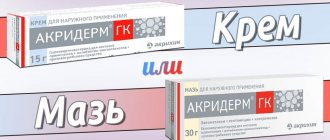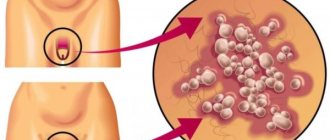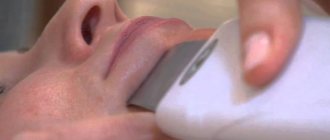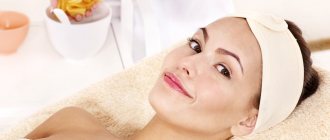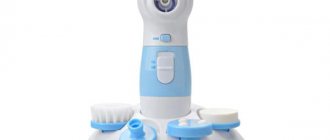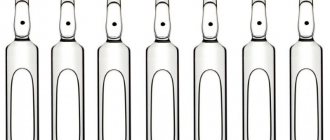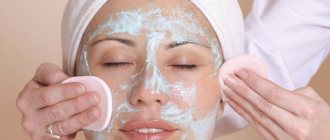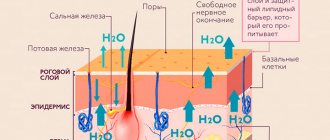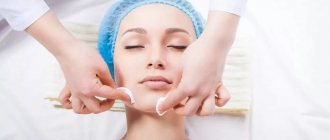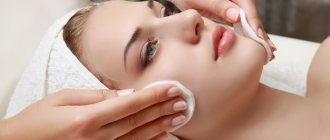It's time to explore the question: peeling or facial cleansing - which is better? After all, as you know, there is no limit to perfection and every woman strives to find new ways to make her appearance irresistible.
Modern cosmetology offers many procedures that help eliminate external light defects and deeper skin problems. With the help of not so complicated manipulations, you can stop the aging process, remove age-related changes, or at least effectively fight them.
Experts are categorically against comparing procedures such as cleansing and peeling. Their similarity is only that they act on epidermal tissue. But the methods, mechanisms and achieved results are different.
What is the difference between the procedures?
Peeling and facial cleansing have completely different characteristics, indications for procedures, age criteria, methods and methods of manipulation.
The main difference between peeling and cleansing is the use of acid-based solutions. The compositions rid the skin of the upper keratinized layers of the epidermis, which no longer fulfill their “functional duties”, acting as ballast, preventing regeneration and cell renewal, and preventing proper breathing, nutrition and moisturizing of the skin.
Products applied to the surface destroy dead layers. As a result, the skin begins to peel off and completely renew itself. The depth of impact on epidermal tissue depends on the composition chosen by the cosmetologist.
What is the difference between cleansing and peeling? First of all, it is designed to solve specific gaps locally. That is, using this method you can get rid of visible defects (pimples, blackheads, comedones, sebaceous plugs) that are located in the deep layers of the epidermis and require mechanical effort to remove.
To carry out cleaning, the master can use various devices, or perform manual manipulation using special tools.
The difference between the procedures is also in the rehabilitation period:
- After peeling, recovery occurs with the inevitable side effect - peeling. Depending on the depth of impact, rehabilitation time can last from a week to four, sometimes even ten;
- After cleaning, other side effects are possible in the form of bruises and hemorrhages in places where particularly deep inclusions were removed. However, recovery is faster - up to two weeks maximum.
It is also worth paying attention to the fact that sometimes cosmetologists advise combining cleansing and peeling. But this factor is of a purely individual nature. More on such nuances a little later.
What are such procedures, what are the differences and differences between facial cleansing and peeling?
The choice between facial cleansing or peeling is not really worth it, because these are 2 different cosmetic procedures.
Cleaning is a process whose name is quite eloquent. With its help, the face is cleansed of accumulated secretions, dust and dirt, remnants of cosmetics and fat. Cleaning opens the pores on the face, eliminates pimples and blackheads, removes sebaceous plugs in the pores of the skin.
Professional cleaning can be done in different ways and is called depending on the products used:
- Mechanical . It is done manually using cosmetics and is quite effective. It will remove blackheads, unripe pimples and other everyday minor troubles.
- Brossage (or brushing). This procedure uses brushes that rotate in different directions and at different frequencies to remove dirt from the pores. But you can’t use it if you have small rashes on your face. Brossage will not eliminate them, but will only lead to skin irritation.
- Ultrasonic. It also cleanses the skin, but at the same time, due to the influence of ultrasound, massages it and helps regenerate soft tissues with massage. You can learn about gas-liquid peeling here.
- Vacuum . It not only cleanses the face of impurities, but also reduces puffiness because it improves both blood circulation and lymph flow.
- Galvanic. A fairly complex procedure in which alkaline solutions are applied to the face, and then a galvanic current breaks down the dirt and sebaceous secretions accumulated in the pores and on the surface.
If everything is neglected, a more complex set of manipulations will be required, and the cosmetologist uses several types of cleansing, combining different methods of cleansing in his work.
Peeling, unlike cleansing, not only cleanses the skin, but also removes its upper stratum corneum, smoothes the skin, rejuvenates, restores it, removes wrinkles and normalizes oiliness. It uses more complex special devices, scientifically developed compositions, and it gives a much more tangible result, even disappearing pigment spots. You can learn about deep facial peeling at home here.
Facial peeling also varies.
- Chemical . Various chemical compounds are applied to the skin, depending on what type - superficial, medium or deep - is needed in a particular case, and with the help of various acids, for example, fruit, salicylic or phenolic, the skin is stimulated to the process of rejuvenation and restoration. This includes amber, yellow and glycolic peels.
- Mechanical . It uses devices of varying degrees of complexity that grind the upper layer of skin. This includes diamond peeling.
- Physical or contactless . With this peeling, laser or ultrasound is used, the effect on the skin is carried out without direct contact.
Enzyme peeling is also available.
Peeling - the secrets of the procedure
First of all, let's consider the indications for peeling:
- increased skin oiliness;
- hyperpigmentation (including age-related);
- age-related changes;
- wrinkles, deterioration of turgor;
- dull complexion.
Experts say that this procedure can be used for any skin type.
Facial restoration by a cosmetologist using peeling can be done in different ways. Procedures are divided into types, which in turn have subtypes.
Mechanical peeling is the most common and safe. According to another classification, it is classified as surface effects. However, here too the depth of penetration of the composition into the epidermis is somewhat different and depends on the specific subtype of the procedure:
- using simple scrubbing compounds. The effect is reminiscent of a massage. Removes the topmost layer of keratinized cells;
- gommage – based on fruit acids. Dissolves and removes the top layer more efficiently, touching the second layer of the epidermis (it consists of five layers);
- microdermabrasion and coral peeling are rougher, but also more effective. The mechanism of action is based on the dispersal of grains included in the composition of the product by a special apparatus.
It is at the same time as mechanical peeling that cosmetologists may recommend cleaning if the skin is very problematic and requires an integrated approach. But let us remind you once again - everything is purely individual!
Physical peeling (according to another classification - medium) also varies in depth of impact. The second or third layer of the epidermis is affected. During the procedure, liquid nitrogen or dry ice is used. The result is restoration of complexion, improvement of oxygen breathing, stopping the processes of skin dehydration
Chemical, deep, phenol peeling is a way to completely remove all old skin. Almost all layers of the epidermis are affected, which are literally dissolved by the aggressive composition. All that remains is the so-called “growth zone” - a thin layer of cells that creates new skin. This method is very controversial; it is not used without special indications.
The procedure is carried out in a hospital setting using strong painkillers (sometimes even general anesthesia), since the pain is very strong. The rehabilitation period also takes place in a hospital, at least two weeks (sometimes up to four). The entire recovery period requires the implementation of special rules, at first - taking painkillers. Its duration can reach up to ten weeks.
Basic information about peeling
The name of the procedure comes from the English verb to peel, which means the action of peeling or exfoliating a fruit. The key task of peeling is to eliminate dead epidermal cells and create conditions for the active growth of new ones. The procedure is performed in aesthetic clinics using special compounds or devices that are recognized to speed up the process of renewing the skin of patients due to their initial injury.
Indications for the procedure
Cosmetologists recommend peeling for patients in the following cases:
- reduction of natural skin radiance;
- roughening of the skin, loss of its softness and elasticity;
- “gray”, uneven complexion;
- increased oiliness of the skin;
- uneven relief, the presence of small scars and cicatrices;
- the presence of blackheads and acne;
- age-related or solar pigmentation;
- pronounced signs of photoaging.
The type of peeling is determined by the doctor at the cosmetology clinic after examining the patient. For girls 18-25 years old, the procedure is recommended to eliminate aesthetic skin imperfections. After 35 years, peeling is considered as an anti-aging therapy tool.
Types of peelings
The procedure is classified based on the depth of damage to the epidermis. Cosmetologists distinguish between superficial, medium and deep types of peeling.
Superficial peeling removes the very top layer of skin cells, which improves its color, smoothes out surface wrinkles, slight hydration, and a soft, light skin renewal effect. All home peels are superficial. They are as safe as possible and do not require restoration.
Medium peeling affects the deeper layers of the skin. Such peelings more effectively correct pigmentation, medium and deep wrinkles, and provide more noticeable hydration and rejuvenation of the skin. Medium peeling requires rehabilitation from several days to a week. Laser resurfacing procedures have become a modern alternative to medium peels, allowing cosmetologists to work safely and in a controlled manner at different depths, achieving excellent results in skin smoothing and rejuvenation.
The most serious peeling is deep, it reaches the deepest layers of the dermis. This procedure must be performed in a surgical setting. Currently, deep peeling is performed extremely rarely, giving way to safer methods of rejuvenation.
The choice of peeling is agreed upon with the patient after the initial examination. The doctor’s recommendations are based on the current condition of the patient’s skin, time of year, and the presence of certain indications.
Expected results of the procedure
The rehabilitation period after professional peeling can take one to two days for superficial effects and up to seven days for deeper effects on the patient’s skin. The result of the procedure is:
- evens out skin tone and improves its quality;
- natural hydration;
- increasing skin density;
- reduction of pigmentation, wrinkles;
- even out complexion;
- reduction of blackheads;
- acne treatment;
- skin glow.
Facial cleansing - what you need to know
By analogy, let’s consider the indications for facial cleansing:
- increased oily skin with enlarged pores;
- comedones (deep and superficial);
- pimples, closed and open;
- millet (millions);
- acne and post-acne;
- hyperpigmentation (including freckles and age spots);
- sebaceous plugs.
A cosmetologist will advise you on which facial cleansing method to use. But in this case, performing a home procedure is safer than peeling. The manipulation is not so aggressive and does not require the use of chemical compounds that can cause an unpredictable reaction.
Cleaning is indicated for those with problematic, oily skin prone to the formation of pimples, blackheads, and sebaceous plugs. But with normal or combined epidermis, sometimes it is also necessary to get rid of the above problems.
Facial cleansing can be carried out both by the hands of a master and using hardware techniques:
- mechanical (manual, manual) - after the preparatory stages, the cosmetologist removes all destructive fragments by hand or with special tools (Unna spoon, Vidal needle, metal loops, brushes);
- Vacuum is carried out using a device that creates negative pressure in a special nozzle. The action is similar to a vacuum cleaner - all the dirt from the pores is sucked out;
- Ultrasonic cleaning is one of the gentle methods with a prolonged effect. Under the influence of ultrasonic vibrations applied to a special scrubber, dirt, sebum, keratinized epithelium and small destructive elements are removed;
- disincrustation (galvanic cleaning) is comparable in effect to manual cleaning. Under the influence of microcurrents, the contents of the pores are broken down and removed;
- laser cleaning – removal of all problem areas using a laser. A good procedure that makes it possible to effectively combat age-related changes.
Another important nuance is that cleansing can be carried out in adolescence, when skin problems arise due to hormonal changes. Whereas peeling is only after 30 years, in rare cases after 25 according to individual indicators.
Peeling and cleaning
Of course, facial cleansing and peeling are among the most popular cosmetic procedures. They allow you to make your skin cleaner and smoother, add health to it and improve its appearance.
To understand the differences between these two procedures and understand how they relate to one another, you need to look at each of them in more detail.
Face cleaning
Facial cleansing is aimed at cleaning pores: removing accumulated dirt and sebum, as well as particles of decorative cosmetics and other substances. The procedure is superficial in nature and allows you to get rid of acne, comedones, and milia.
Types of facial cleansing:
- Ultrasonic. It is performed using a special device, through a spatula-nozzle of which ultrasonic acoustic waves are applied to the skin. Ultrasound performs a vibration massage of tissues, eliminates keratinized scales, activates blood flow and opens oxygen to the skin, which helps improve metabolism and skin tone in general. However, this type of cleansing is completely ineffective in the fight against comedones.
- Vacuum. It is performed using a special device with a nozzle capable of pumping air, creating a vacuum - negative pressure. This procedure perfectly activates blood circulation and promotes rapid resorption of congestion. In addition, vacuum cleaning improves metabolic processes in tissues. But it does not help cope with severe pore contamination.
- Galvanotherapy. This skin cleansing procedure is also called disincrustation. Its essence is the directed effect of electric current on the skin. Before performing the procedure, a special solution is applied to the face, which penetrates into the pores and effectively breaks down impurities. Cosmetologists claim that galvanic cleaning can be an excellent alternative to mechanical cleaning. This procedure does not cause discomfort and does not cause damage to the skin, which is certainly a significant advantage.
- Mechanical or manual. This procedure is considered the most effective in the fight against acne, but is painful. Its essence consists of manual cleaning of pores - a specialist squeezes out comedones or removes impurities using special devices. After the skin has been cleansed, it remains red for several days and requires special care. In particular, you need to protect yourself from the sun's rays, switch to using mild care products, and avoid injuring your face with a scrub for at least one to two weeks.
Each type of facial cleansing begins with preparing the skin for the procedure, in particular, substances that can loosen the skin and comedones are applied to the face.
After completing all the manipulations, various masks and lotions with soothing and caring qualities are also used.
Peeling
Peeling is a more serious procedure, as it is aimed at deeper cleansing of the skin. Typically, such manipulation is carried out using various acids (they may differ in origin and concentration), which effectively dissolve sebum along with the top layer of dead epidermal cells.
There are several types of chemical peeling (using acids):
- Surface. It is considered the safest and easiest. The active substances in this procedure act only within the stratum corneum of the epidermis. To carry out superficial peeling, soft acids are used, for example, glycolic, lactic, malic, phytic, almond, etc. This procedure can improve complexion, reduce age spots and reduce skin oiliness. In addition, it promotes the active course of regeneration processes, smoothing wrinkles and leveling the relief.
- Median. It affects the entire length of the epidermis, right down to the papillary layer of the dermis. It is carried out using salicylic, retinoic or trichloroacetic acid. Jessner's solution can also be used. Medium peeling is a fairly uncomfortable (often painful) procedure and requires some recovery - about two weeks. Carrying out such manipulation becomes a powerful message for launching regenerative processes in the skin. Medium peeling promotes the formation of new cells, the appearance of new capillaries and the activation of collagen and elastin production.
- Deep. It is the most complex type of peeling and belongs to dermatosurgical procedures. When performed, the active substances reach the papillary layer of the dermis. Deep peeling is carried out using phenol in the form of a solution; it gives a lifting effect, but is painful and has a fairly large list of contraindications. After such a procedure, the patient needs to recover from a couple of months to six months. And it gives a noticeable rejuvenating effect, because the skin dissolves as deeply as possible. The epidermis is restored from a thin layer of cells, the so-called growth zone.
It is important to note that deep peeling is carried out exclusively with the use of anesthetics - painkillers. Only a highly qualified specialist can perform it.
Peeling can also be:
- Mechanical. It involves the use of various devices that provide exfoliation and polishing of the upper layers of the skin.
- Physical or contactless. To carry out this procedure, laser and ultrasound are used.
After any type of peeling, the skin begins to actively recover. At the same time, the barrier capabilities of the skin increase, collagen, elastin and hyaluronic acid are more actively produced. Peeling also helps normalize metabolism in tissues.
To combine or not to combine - that is the question
Peeling and cleansing, by and large, are procedures designed to solve the same issues. This is their similarity. But the mechanism of action is completely different. We conclude that they may well complement each other, especially when solving significant problems.
The question naturally arises: is it necessary to cleanse the face before peeling? What is better - peeling or cleansing first? Is it possible to exfoliate without cleansing your face and vice versa?
Don't try to solve this dilemma on your own. Leave it to the professionals to decide what to do in each case. Only after diagnosis will they tell you what is best.
Are there any contraindications?
Like every cosmetic procedure, cleansing and peeling have their own direct contraindications.
Facial cleansing should not be carried out in the following cases:
- individual intolerance;
- the presence of dermatological pathologies;
- herpes in acute form;
- hypertonic disease;
- mental disorders;
- dry, sensitive surface of the epidermis;
- critical days, a couple of days before and after - there are hormonal disruptions, the pain sensitivity threshold increases.
For peeling, there are the following prohibitions:
- individual intolerance;
- very sensitive skin.
- dermatological diseases;
- infectious diseases;
- elevated body temperature, regardless of the cause;
- hypertension;
- heart and kidney diseases;
- herpetic infection;
- mental disorders;
- pregnancy and lactation period.
Impacts on the skin should not be carried out during menstruation, a few days before and after it.
A cosmetologist about what is better:
Combination of procedures
Many clients of cosmetology clinics are interested in how facial cleansing and peeling are combined. Of course, a qualified specialist can answer such questions.
So, quite often cosmetologists recommend doing facial cleansing a few days before peeling. This makes it possible to increase the effectiveness of the procedure by an order of magnitude. But most often, experts advise waiting about one week after cleansing until the skin’s hydrolipidic barrier is restored. It is especially important to pause between procedures if there is a need to eliminate existing traces of rashes or stagnant spots.
As for facial cleansing after peeling, the approach to combining such procedures differs depending on the list of products used, as well as the qualifications of the cosmetologist. Some specialists practice superficial peeling with acids immediately before cleansing the face. In this case, preference is given to the use of salicylic, mandelic and pyruvic acid.
Sometimes it is possible to perform a light superficial peeling, and after 3-5 days, cleansing.
In some situations, a cosmetologist may begin working on the client’s face with a superficial peel, then begin facial cleansing, and finish the procedure by re-applying the peel. If there are many comedones and inflamed areas on the skin, cleaning is often completed with a superficial alcohol-based salicylic peel. This procedure is quite aggressive and painful, but gives a good effect.
In the event that medium or deep peeling is planned, cleaning is not done either before or after it, because during the procedure the skin is quite seriously injured. In the future, cleaning can be carried out only after complete restoration of the skin (after 1–6 months).
If you carry out peeling and cleansing at the same time, it traumatizes the skin much more than performing such manipulations separately, with a certain time interval. An experienced cosmetologist can accurately answer questions about whether it is necessary and possible to do peeling after cleansing the face and cleansing after peeling.
Recommendations from cosmetologists
Chemical peeling and facial cleansing are procedures that, to a greater or lesser extent, still injure the epidermis. Cosmetologists advise following simple rules to speed up the recovery process.
After peeling you need:
- do not wet your face for 24 hours (if you used deep chemical peeling – up to 3-4 days);
- Do not remove developing crusts under any circumstances;
- do not visit places with high humidity and air temperature (sana, bathhouse, swimming pool, beach);
- do not sunbathe or visit a solarium;
- do not use products containing alcohol;
- apply moisturizing and nourishing creams according to your skin type;
- Use sunscreen before going outside.
After cleansing your face you should:
- do not wash your face for a day, wipe your face with soothing, cleansing lotions without alcohol;
- Do not forcibly tear off crusts if they form;
- do not expose your face to sunlight for two days;
- sauna, baths, swimming pools, beaches - taboo for at least a week;
- preference should be given to cleansing gels and alcohol-free lotions with a calming effect;
- Apply moisturizing and nourishing products according to your skin type. If necessary, use healing ointments.
The cosmetologist will tell you how often to do the procedure.
Reviews
We have already figured out how peeling differs from facial cleansing. Reviews will help you get a complete picture.
Victoria, 25 years old, Moscow
“I cleanse regularly because I have oily, problematic skin. Recently, a cosmetologist advised me to peel my face with fruit acids a week after cleansing. The effect is amazing. This procedure complemented the cleaning, made it better and longer lasting.”
Marina, 32 years old, Ramenskoye
“When I asked what is better to cleanse my face - peeling or ultrasonic cleansing, the master at the salon told me that it was too early for me to think about peeling, since the skin looked quite good. I understand that it is not at all necessary to “burn” your face unless absolutely necessary.”
Oksana, 48 years old, St. Petersburg
“I did peeling with liquid nitrogen. The exfoliation took place for at least two weeks. It’s good that you took a vacation, otherwise at least don’t show up for work. But there is an effect - the face has become fresher, the spots have disappeared"
Tatyana, 40 years old, Ryazan
“Ultrasound facial cleansing is the best procedure for me. I do it regularly and am quite pleased with the result. But a friend went to get a chemical peel and I didn’t see her for a month. She didn't even invite me to visit. Only later did she tell me what a nightmare it was. I definitely won’t do that.”
Olga, 35 years old, Tomsk
“I have been using scrubs with fruit acids on my own for a very long time. As it turned out, this is also peeling, which is not so scary. It’s probably time to contact a cosmetologist for a professional service.”
Summary
Salon procedures designed to make a woman’s appearance more attractive, get rid of defects, and stop aging are excellent methods. But you need to understand the nuances even before going to a cosmetologist.
Whether you can peel after cleansing your face depends on your individual characteristics. We can definitely say that such a procedure is unlikely to be carried out right away. After all, the skin must recover from previous exposure. Remember these nuances.
And most importantly, look for “your own,” experienced, responsible cosmetologist. Only then can you be 100% sure.
Peeling at home
Peeling or facial cleansing: which is better? When choosing between these two procedures, many people prefer the first, and plan to carry it out at home. All recommendations from cosmetologists boil down to the fact that the optimal frequency of their implementation is 2-3 times a week.
To carry out this procedure, it is necessary to use only natural compounds, the action of the components of which is aimed at eliminating certain skin problems, as well as active cell regeneration. Moreover, the valuable quality of peelings is their ability to nourish skin cells and also saturate them with collagen. Some representatives of the fair sex prefer to carry out home peelings after cleansing their faces. Reviews about this procedure say that after using a properly selected product, the skin looks more beautiful, fresh and much younger. Some comments say that after regular home scrubbing, small expression wrinkles are smoothed out.
Cosmetologists recommend performing such procedures at home no earlier than after reaching 25 years of age.
